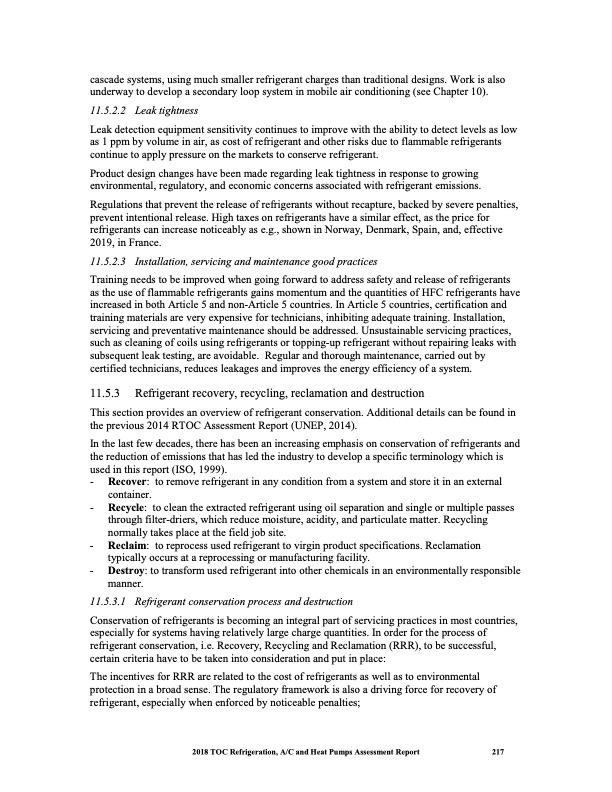
PDF Publication Title:
Text from PDF Page: 230
cascade systems, using much smaller refrigerant charges than traditional designs. Work is also underway to develop a secondary loop system in mobile air conditioning (see Chapter 10). 11.5.2.2 Leak tightness Leak detection equipment sensitivity continues to improve with the ability to detect levels as low as 1 ppm by volume in air, as cost of refrigerant and other risks due to flammable refrigerants continue to apply pressure on the markets to conserve refrigerant. Product design changes have been made regarding leak tightness in response to growing environmental, regulatory, and economic concerns associated with refrigerant emissions. Regulations that prevent the release of refrigerants without recapture, backed by severe penalties, prevent intentional release. High taxes on refrigerants have a similar effect, as the price for refrigerants can increase noticeably as e.g., shown in Norway, Denmark, Spain, and, effective 2019, in France. 11.5.2.3 Installation, servicing and maintenance good practices Training needs to be improved when going forward to address safety and release of refrigerants as the use of flammable refrigerants gains momentum and the quantities of HFC refrigerants have increased in both Article 5 and non-Article 5 countries. In Article 5 countries, certification and training materials are very expensive for technicians, inhibiting adequate training. Installation, servicing and preventative maintenance should be addressed. Unsustainable servicing practices, such as cleaning of coils using refrigerants or topping-up refrigerant without repairing leaks with subsequent leak testing, are avoidable. Regular and thorough maintenance, carried out by certified technicians, reduces leakages and improves the energy efficiency of a system. 11.5.3 Refrigerant recovery, recycling, reclamation and destruction This section provides an overview of refrigerant conservation. Additional details can be found in the previous 2014 RTOC Assessment Report (UNEP, 2014). In the last few decades, there has been an increasing emphasis on conservation of refrigerants and the reduction of emissions that has led the industry to develop a specific terminology which is used in this report (ISO, 1999). - Recover: to remove refrigerant in any condition from a system and store it in an external container. - Recycle: to clean the extracted refrigerant using oil separation and single or multiple passes through filter-driers, which reduce moisture, acidity, and particulate matter. Recycling normally takes place at the field job site. - Reclaim: to reprocess used refrigerant to virgin product specifications. Reclamation typically occurs at a reprocessing or manufacturing facility. - Destroy: to transform used refrigerant into other chemicals in an environmentally responsible manner. 11.5.3.1 Refrigerant conservation process and destruction Conservation of refrigerants is becoming an integral part of servicing practices in most countries, especially for systems having relatively large charge quantities. In order for the process of refrigerant conservation, i.e. Recovery, Recycling and Reclamation (RRR), to be successful, certain criteria have to be taken into consideration and put in place: The incentives for RRR are related to the cost of refrigerants as well as to environmental protection in a broad sense. The regulatory framework is also a driving force for recovery of refrigerant, especially when enforced by noticeable penalties; 2018 TOC Refrigeration, A/C and Heat Pumps Assessment Report 217PDF Image | Heat Pumps Technical Options

PDF Search Title:
Heat Pumps Technical OptionsOriginal File Name Searched:
RTOC-assessment-report-2018_0.pdfDIY PDF Search: Google It | Yahoo | Bing
CO2 Organic Rankine Cycle Experimenter Platform The supercritical CO2 phase change system is both a heat pump and organic rankine cycle which can be used for those purposes and as a supercritical extractor for advanced subcritical and supercritical extraction technology. Uses include producing nanoparticles, precious metal CO2 extraction, lithium battery recycling, and other applications... More Info
Heat Pumps CO2 ORC Heat Pump System Platform More Info
| CONTACT TEL: 608-238-6001 Email: greg@infinityturbine.com | RSS | AMP |